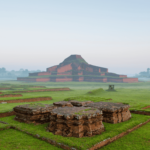Introduction:
Bangladesh is like a living, breathing history book! You don’t need to be a history enthusiast to be captivated by its rich cultural heritage, but if you are, you’re in for an absolute treat. From ancient ruins that whisper tales of Buddhist monks to majestic Mughal forts, Bangladesh offers a captivating journey into the past. Whether you’re exploring centuries-old mosques or wandering through abandoned colonial cities, there’s a story behind every corner. Let’s take a tour through some of the most iconic historical sites in Bangladesh—places that every traveler should experience.

Dhaka: The City of Historical Splendor
Dhaka, the bustling capital of Bangladesh, has a rich history that spans centuries. Despite its modern chaos, the city has pockets of historical gems that transport you back in time.
-
- Lalbagh Fort: Built in the 17th century, this unfinished Mughal-era fort is one of Dhaka’s most iconic sites. Walking through its gardens and walls, you can almost feel the echoes of history—this fort was the center of many political and military conflicts during the Mughal reign.
-
- Ahsan Manzil: Known as the “Pink Palace,” Ahsan Manzil was once the residence of the Nawabs of Dhaka. It now stands as a museum, giving visitors a glimpse into the grandeur of 19th-century life. The architecture alone is worth the trip!
-
- Star Mosque: This small yet stunning mosque is a prime example of Mughal architecture with a unique twist—it’s decorated with thousands of tiny mosaic stars, a signature feature that gives the mosque its name.
-
- Armenian Church: Dating back to the colonial period, this church is a testament to the Armenian community that once flourished in Dhaka. It’s a quiet escape from the hustle and bustle, perfect for reflection.

Bagerhat: The Mosque City of Bangladesh
Bagerhat, a UNESCO World Heritage Site, is known for its abundance of ancient Islamic architecture. If you love history and spirituality, this place will blow you away.
-
- Sixty Dome Mosque (Shat Gombuj Masjid): This mosque is the crown jewel of Bagerhat, built by the great saint Khan Jahan Ali in the 15th century. Despite its name, it has 77 domes and is one of the largest and oldest mosques in Bangladesh.
-
- Tomb of Khan Jahan Ali: The founder of Bagerhat, Khan Jahan Ali’s tomb is a sacred place for locals. The serene atmosphere surrounding the tomb makes it a peaceful spot for visitors.
-
- Nine Dome Mosque: Another masterpiece of Islamic architecture in Bagerhat, this mosque is slightly smaller but no less impressive. The intricate designs in the brickwork are a highlight.
-
- Zinda Pir Mosque: A more hidden gem in Bagerhat, this mosque is quieter and less frequented by tourists, making it an excellent spot for those who want to escape the crowds.

Paharpur: The Ancient Buddhist Monastery
Paharpur is home to Somapura Mahavihara, one of the largest and most important Buddhist monasteries in South Asia. Designated as a UNESCO World Heritage Site, it’s a must-visit for anyone interested in ancient history.
-
- Somapur Mahavihara: Dating back to the 8th century, this vast monastery complex once housed thousands of monks. The layout of the monastery reflects its spiritual importance, and as you walk through the ruins, you can still sense the devotion that permeated the air here centuries ago.
-
- Paharpur Archaeological Museum: This small but fascinating museum is packed with artifacts unearthed from the site, including stone sculptures and terracotta plaques. It’s a great way to deepen your understanding of the region’s Buddhist history.
-
- The Terracotta Plaques: The intricate designs on these plaques are nothing short of mesmerizing. They tell stories of gods, animals, and everyday life in ancient Bengal, giving visitors a glimpse into the past.

Mainamati: The Seat of Buddhist Civilization
Mainamati is another essential stop for those interested in Bangladesh’s Buddhist past. The ruins here date back more than a thousand years and are spread across a series of ancient monasteries and temples.
-
- Mainamati Ruins: The sheer size and scope of the ruins are awe-inspiring. Walking through the remains of ancient monasteries, you can imagine the thriving Buddhist community that once existed here.
-
- Shalban Vihara: This is the most prominent monastery in the area. With its well-preserved stupas and walls, it’s a prime example of early Buddhist architecture in Bangladesh.
-
- Mainamati Museum: Packed with ancient artefacts, this museum is a treasure trove of history. From religious sculptures to everyday items, the exhibits provide a well-rounded view of life in ancient Bengal.

Sonargaon: The Ancient Capital of Bengal
Once the capital of Bengal, Sonargaon is a must-visit for anyone interested in the pre-colonial history of Bangladesh.
-
- Panam City: A hauntingly beautiful abandoned city that dates back to the colonial era. The crumbling mansions and narrow streets are reminiscent of another time and offer excellent photography opportunities.
-
- Goaldi Mosque: One of the few surviving structures from the Sultanate period, Goaldi Mosque is a small but architecturally significant building that highlights the Islamic heritage of the region.
-
- Folk Art and Craft Museum: This museum provides a fascinating look into traditional Bengali art and craftsmanship, with exhibits showcasing everything from pottery to weaving.

Mahasthangarh: The Oldest City in Bangladesh
Mahasthangarh is a must-see for anyone interested in the ancient history of Bangladesh. This site dates back to at least the 3rd century BC and is one of the oldest archaeological sites in the country.
-
- Mahasthangarh Citadel: This fortress once stood as a major city and political centre. Today, you can explore the ruins and imagine what life was like in ancient Bengal.
-
- Govinda Bhita Temple: Situated on the banks of the Karatoya River, this ancient temple dedicated to Lord Vishnu offers breathtaking views and a serene atmosphere.
-
- Jiyat Kunda (Well of Life): Surrounded by myths and legends, this ancient well is believed by locals to have healing powers.
Gaur: The Ancient City of Bengal
Gaur was once a thriving city, and its ruins today are a testament to its historical importance.
-
- Chhota Sona Mosque: Known as the “Small Golden Mosque,” this structure is an excellent example of Sultanate-era architecture, adorned with intricate terracotta designs.
-
- Darasbari Mosque: This large mosque is another beautiful remnant of the Sultanate period, showcasing impressive brickwork and design.
-
- Firoz Minar: A towering monument built by Sultan Saifuddin Firoz Shah, this structure offers a stunning view of the surrounding countryside.
Barisal: The Land of Temples and Rivers
Barisal, often referred to as the “Venice of the East,” is not only famous for its rivers but also its rich historical and religious heritage.
-
- Durga Sagar: This is the largest man-made lake in southern Bangladesh, and it’s surrounded by several temples that add to its cultural significance.
-
- Guthia Mosque: A relatively modern structure, Guthia Mosque is one of the most beautiful mosques in the country, combining traditional and contemporary Islamic architecture.
-
- Oxford Mission Church: One of the oldest and largest Christian churches in Bangladesh, it stands as a symbol of the country’s religious diversity.
Conclusion:
Exploring the historic sites of Bangladesh is like stepping back in time. Whether you’re walking through the ancient ruins of Paharpur or marveling at the grandeur of Lalbagh Fort, these places offer more than just a look at the past—they connect you to the soul of a country with a rich and diverse cultural heritage. If you love history, Bangladesh will surely enchant you with its stories, legends, and breathtaking architecture. Ready to explore? Don’t forget to share your experiences and insights—your travel story might inspire the next adventurer!







